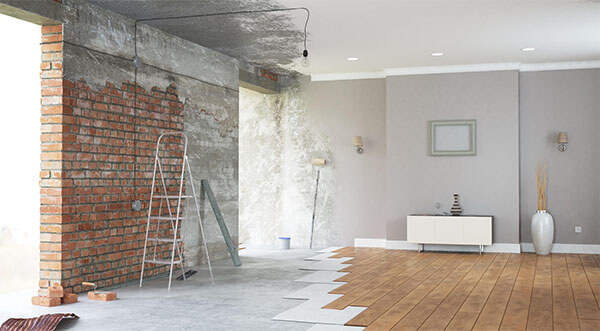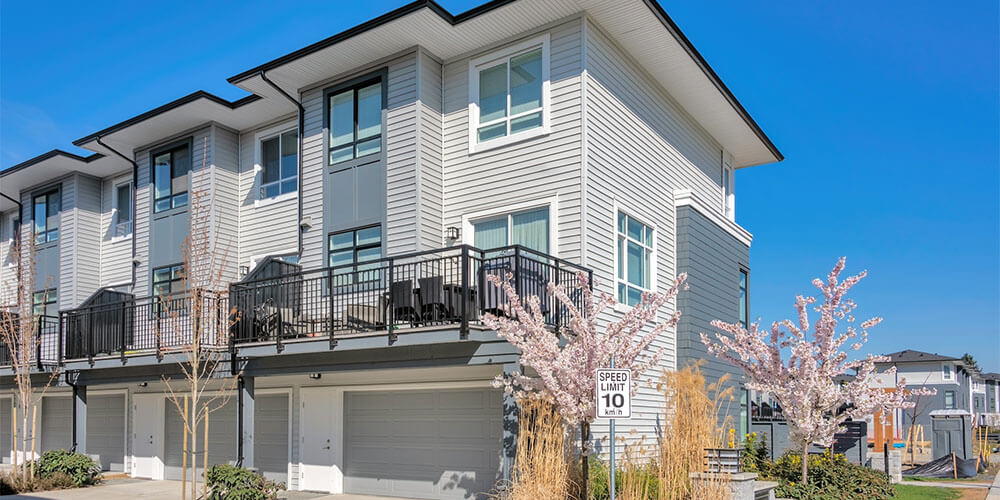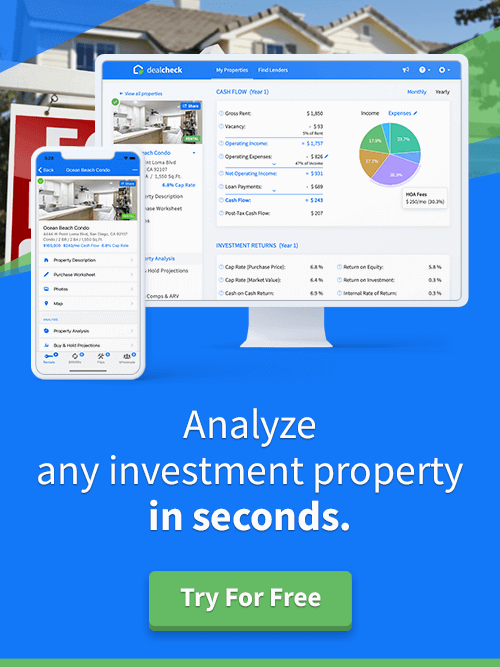The following is a post written by Luke Babich, a guest contributor to the DealCheck blog.
Townhomes (sometimes called townhouses) are not the most common form of housing in many areas. But they’re growing in popularity, with many would-be homeowners and renters recognizing the value of these multi-level units, which are typically attached to neighbors on one or both sides and often include front or back yards.
From their roots in the Northeast in the 1600s, to modern developments across the country, this affordable style of community living has become a solid investment as a rental or fix-and-flip.
But before getting to work, it’s critical to consider your return on investment (ROI) and ways to improve it.
Are Townhomes a Good Investment?
Some investors shy away from townhomes, believing they are a risky proposition due to their connection with other structures and homeowners’ association (HOA) fees.
But after single-family homes, townhouses offer the most bang for your buck on the rental market and may appeal to buyers with less to spend on a home. They can be more affordable than single-family homes, and because you aren’t responsible for as much exterior maintenance, some improvements are more affordable.
The same can’t be said of condos. Condominium ownership does not include the land beneath you — only the unit itself and a share of the condo’s common areas. In addition, many are only one level, a layout not suitable for all buyers or renters.
As with some townhouses, monthly HOA dues generally pay for some basic maintenance, including landscaping and exterior care, but these fees can sometimes soar into the thousands.
Meanwhile, some HOAs don’t offer much in the way of amenities or services but include significant restrictions on improvements or other changes you can make to the property.
How to Determine Which Townhome to Buy
It’s essential to do some research before investing in townhomes. Consider the initial investment, plus any renovations that will be needed before securing a tenant or flipping the property.
If you are buying a move-in-ready townhome, be prepared to pay a little more, but make sure you can rent it for a price that covers your costs.
In either case, you can use DealCheck’s free rental property or fix-and-flip calculators to help you analyze your potential profits and investment returns and decide whether a particular property is worth investing in.
15 Ways to Maximize Your ROI
While all investors want to maximize their profits, there are plenty of different ways to upgrade a property with ROI in mind. Here are 15 of the best strategies:
1. Understand the Rental Market
Like any real estate investment, a crucial part of buying a townhome (along with picking the right Realtor) is understanding local market trends and buyer preferences. When upgrading a townhome already in your portfolio, the same due diligence is critical.
Pay attention to what the prospective occupants of your home are looking for. New families may want improved outdoor areas, but a younger demographic might prefer smart features and inside space for entertaining.
Don’t make changes based on what you’d like to have — upgrade for your area’s potential tenants and buyers. You may like the idea of a chef’s kitchen with upscale stainless appliances, but if you’re renting in a college town, you might be upgrading yourself out of your tenant base.
2. Consider Eco-Friendly Materials
An often-ignored way to improve a project’s ROI is to consider using eco-friendly materials for renovations or remodels.
Sustainable materials such as bamboo flooring, recycled glass countertops, or paints with fewer harmful chemicals are attractive to renters and buyers focused on eco-conscious options.
3. Highlight the Curb Appeal
One of the easiest ways to boost the value of a home is to spruce up its exterior.
Because townhomes offer a more manageable amount of space to improve, this is often one of the most affordable upgrades relative to the returns it can generate. Add a coat of fresh paint and containers of flowers or perennial plants to make a front porch more inviting.
Owners can also upgrade the house numbers and light fixtures to a more modern style and consider replacing an old, dated front door. However, since many townhomes are part of HOAs that may have restrictions on exterior changes, owners should always ensure they’re not violating any community rules first.
4. Paint the Interior
A fresh coat of neutral paint throughout the interior goes a long way toward affordably upgrading a space. It gives potential renters or buyers a blank canvas on which they can mentally paint their own style.
Fresh paint also gives the impression that the home has been well cared for, another significant advantage when it’s time to sell.

5. Level Up Kitchen Appliances
While they’re often the cheapest, ordinary white appliances show their wear quickly and can make even relatively new kitchens look dingy. Look instead for energy-efficient, stainless steel appliances for a timeless appeal.
Some investors believe outfitting a kitchen cheaply is important because renters might damage it, but it’s often a better move to upgrade appliances to attract more responsible tenants.
6. Modernize Kitchen Materials
Don’t pair your sleek new kitchen appliances with low-end Formica and particleboard. Provide a kitchen makeover by updating countertops, cabinets, and backsplashes with more contemporary materials like quartz, soapstone, and even sealed concrete.
If new cabinets are out of budget, consider refacing the doors and replacing drawer handles.
7. Update Hardware and Fixtures
While you’re changing out the door and drawer handles in the kitchen, you might as well make similar small upgrades throughout the house.
Swap outdated door handles, knobs, faucets, and light fixtures for streamlined options that are more appealing to modern buyers or renters.
8. Reorganize the Floor Plan
Open floor plans can make smaller homes seem more inviting and spacious. However, this may not be a great idea if your tenants or buyers will likely need separate spaces for remote work or other purposes.
If open floor plans are popular in your area, talk with a contractor to locate non-load-bearing walls and get ready to move things around. Make sure you do the ROI math first, as this can be one of the most expensive and time-consuming upgrades.
9. Add Storage
Townhomes are an excellent option for young families and first-time homeowners, but these residents need plenty of space to store their stuff.
Add innovative storage solutions like built-in shelving, under-stair storage, and closet organizers to maximize space and improve functionality.
10. Improve Flooring
Outdated flooring is a hallmark of cheap rental properties and beat-up homes. But there are durable, affordable, attractive flooring options that can boost your ROI and provide a luxurious look and feel at the same time.
Hardwood floors are popular but sit at the upper end of many homeowners’ budgets. Meanwhile, laminate and luxury vinyl have come a long way in recent years in both appearance and price, proving you don’t have to break the bank to upgrade flooring.
11. Freshen Up the Bathroom
On average, a full bathroom remodel offers a 70% return on investment, but you don’t need to empty your wallet to revitalize this critical part of the home.
Simple upgrades to fixtures, faucets, and lighting give bathrooms a modern and luxurious feel. Bring a spa atmosphere to your property by adding a rain showerhead or soaking tub if the budget and space allow.
12. Get Better Lighting
Brighter spaces look cleaner and more inviting. Install LED light fixtures to lighten up spaces and reduce energy costs for you and your renters. Dimmer switches are another easy upgrade that most investors can take care of themselves.
13. Be Smarter
Smart home technology like programmable thermostats, keyless entry systems, and security cameras appeal to tech-savvy tenants and buyers. Look for options that accommodate multiple users and can be easily reprogrammed.
14. Upgrade Outdoor Living
Outdoor living came into the spotlight during the height of the COVID-19 pandemic as many looked to outdoor entertaining as a safer alternative.
If your townhome’s outdoor space has seen better days, plan to improve balconies or patios. Add built-in seating areas if possible, and consider a firepit, small garden area, and fencing to attract young families or people with pets.
15. Invest in Energy Efficiency
Some energy investments like Energy Star appliances or more efficient HVAC systems can cost thousands of dollars, but that doesn’t mean more wallet-friendly and ROI-focused options aren’t available.
While budgeting for major improvements, take small steps toward energy efficiency.
Upgrade the windows, add attic and basement insulation, and make sure all windows, walls, and doors are properly sealed. These small improvements are budget-friendly and appeal to environmentally-conscious tenants or buyers.
Plan Ahead — Upgrade Over Time for Maximum ROI
Upgrading an investment property to achieve the maximum ROI can be stressful — and expensive. If you’re upgrading on a budget and want to get the most out of your improvements, start small and save for larger ticket items that take longer but yield solid, reliable returns.
If you can’t renovate a bathroom right now, swap out the fixtures, paint, and be on the lookout for deals on tubs, toilets, and sinks for when the time is right. No room in the budget for a two-story deck off the back of the townhouse? Invest in a multi-stage, two-story building plan that can be completed in phases.
The key to a solid return on your capital investment is good research and careful planning.

Luke Babich is a licensed real estate agent and is the co-founder of Clever Real Estate, a real estate education platform committed to helping home buyers, sellers and investors make smarter financial decisions.


